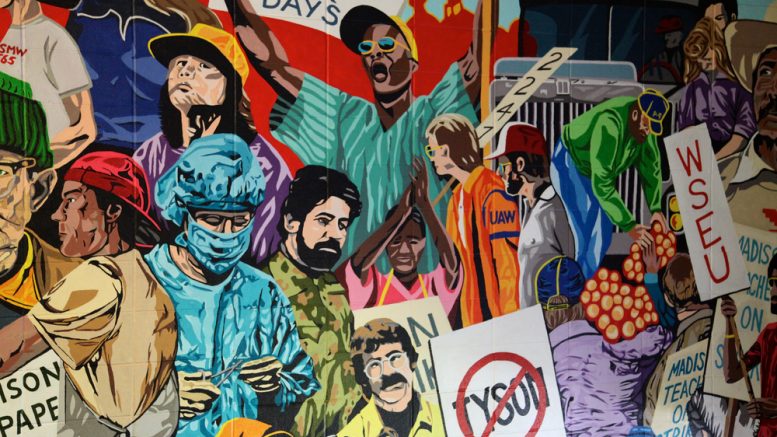
By Tom Crofton
The Commoner Call (6/26/17)
In 2010 attention of the world was riveted when 33 miners were trapped 2,300 feet underground in the Copiapó Chilean mining accident. The miners were trapped underground for 69 days and were only freed after an international rescue effort. The 2015 movie entitled “The 33”, available on DVD in local libraries, tells the story of what happened and how the incident impacted the miners, their families and communities. .
A great deal has been written on this event and some may tell a slightly different story, but the movie depicts the site as a worn out old mine whose owners flaunted and shaved modern underground safety practices in order to extract greater and greater tonnage of ore daily.
Previous geological instability and a long record of safety violations for the mine’s owners, San Esteban Mining Company, had resulted in a series of fines and accidents, including eight deaths, during the dozen years leading up to this accident.
Safety violations included external combustion engines used underground, a single exit/entrance, conventional trucks used to haul miners along a 5-kilometer ramp down to the workface, unfinished safety ladders through airshaft chimneys, an almost empty first aid cabinet, and a skimpy pantry of canned food in the refuge chamber were some of the conditions when a massive cave-in trapped the 33 men. Just as in any group, there were personal conflicts and a dysfunctional hierarchy of authority that failed the miners in the first place and almost destroyed them during their ordeal. Additionally, the government, run by a former billionaire banker and one time supporter of Pinochet, Sebastián Piñera, was slow to respond to the crisis.
In the movie, the on-site manager was in the act of giving up on any attempt to rescue the trapped men when the State Head of the Department of Mining arrived.
A rebirth of union solidarity, in an international framework of building a peaceful, prosperous world for all, going beyond an adversarial stance to take responsibility for what we produce and how we produce it, may be our best and only hope.
The mining official works with the town folk to build a tent city with food and schools and basic necessities to handle the crowds hoping for a rescue. A Chilean mining engineer is brought in and hi-tech drilling equipment arrives from all over the world to eventually drill a 5-inch diameter hole to the refuge chamber, through which supplies sent down into the dark. A larger hole to serves as a tube for an escape capsule finally reaches the men so they can be pulled to the surface. Over a billion people around the globe watched the men emerge from the ground.
The technical details of the disaster and rescue are available elsewhere, and the movie may cut some corners on the actual facts, but it shows the connection between the community in the pit and the one a mile above on the surface in a series of dreams, hallucinations, demonstrations, rituals, and songs of a vibrant blue-collar community being tested to the breaking point.
The solidarity that develops requires confession, introspection, and a willingness to break old personal patterns, and even if the emotional aspects of this movie are fiction, they offer a lesson for those of us in our lone cowboy “America First” mode.
The predictable betrayals
After a three-year investigation and despite the clear record of negligence and past onsite deaths, the mining company was never charged with criminal neglect or fined. It sold the mine to pay for part of the rescue attempt.
Even now, years later the 33 miners have found themselves blacklisted from working in mines, said Omar Reygadas, one of the men who was trapped nearly 700 meters underground for 10 weeks.
“Most mine owners are afraid to hire us because they think that if there’s ever a problem everyone will immediately find out about it since we get a lot press. We’re well known,” Reygadas says.
Renato Prenafeta, a lawyer who represents 31 of the 33 miners, is analyzing the prosecutor’s decision before announcing whether he will fight it. A civil suit seeking millions of dollar in compensation was not affected by the decision to drop the criminal investigation. He confirmed the men have a host of ongoing emotional and psychological problems from the trauma and confirms it is nearly impossible for them to find jobs.
Immediately following their dramatic rescue the miners were showered with gifts including $20,000 cash, a trip to Disneyland and a cruise around the Greek islands. Today many of the men are struggling to balance their emotional health with day-to-day financial needs.
While the movie told their story, the miners felt they were once again betrayed and cheated.
A few thoughts
The Chilean Mine Disaster follows the classic Greek concept of Tragedy: an act predicted and then acted out as if no other possibility existed, in the full knowledge of the actors.
The miners had previously documented the shifting mountain before the collapse. They knew what a dangerous job they had even if the best methods were in force. Their foreman complained up the chain of command that the mine was in danger of collapse and was repeatedly told he needed to push production higher. The company had been fined for lax safety procedures before. The President of Chile had been in a series of scandals but was elected by the oligarchy to keep a lid on liberal democratic movements springing up. And little has changed since.
The human spirit has a deep capacity to rise to crisis, and our American spirit is famed for that capacity. We must not let our collective power be blinded and dissipated by the “divide and conquer” propaganda offered by an oligarchy that seeks to prevent us from realizing our common bonds. We need to prevent crises by taking positive, preventive action before they happen. A rebirth of union solidarity, in an international framework of building a peaceful, prosperous world for all, going beyond an adversarial stance to take responsibility for what we produce and how we produce it, may be our best and only hope.
- View The 33 movie trailer, HERE.
- For A Detailed Timeline Of The Chilean Mining Accident, link HERE.

